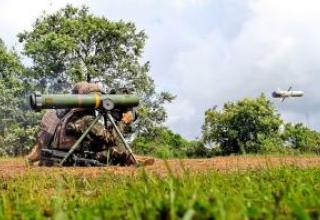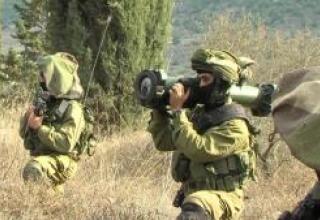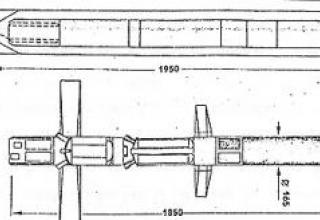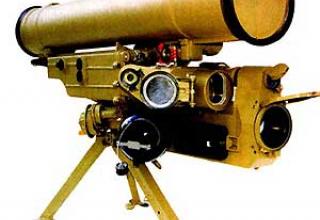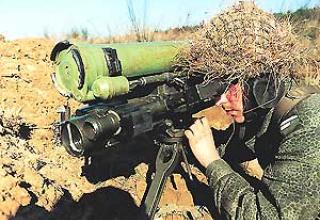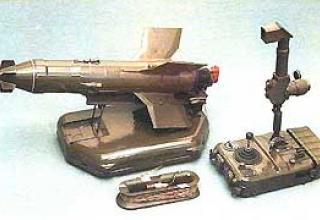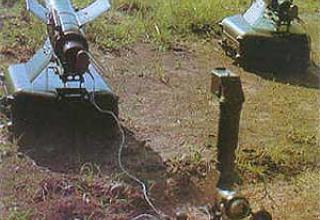At the end of May 1988, the American company Hughes Aircraft signed an agreement with the Spanish consortium Esprodesa to develop a medium-range vehicle, which will be a serious competitor to the European medium range wearable complex AGTW-3MR of EMDG association.
In October 1988, Hughes Aircraft and the Esprodesa consortium, which includes three Spanish companies Ceselsa, Instalaza and Union Explosivos, were to create a new Spanish-American association, the name of which is not known, with headquarters in Madrid. The joint venture will have a total equity capital of $260 million, of which 60 percent ($160 million) will belong to Esprodesa and 40 percent to Hughes Aircraft. The Aries PTC development project is estimated at $134 million.
Hughes Aircraft provides overall program management, guidance and missile control system development and technical assistance to its partners.
The Esprodesa Consortium is responsible for the development of a new launcher, marching engine and BC of the missile, an embroidery propulsion system, participates in the development of ground control equipment using the millimeter-wave band (instead of wire communication), is also responsible for the production of the Aries system.
According to the Esprodesa consortium, the Aries missile will have a high probability of hitting a target and a well-trained operator will be able to perform three launches per minute, while the Aries ATGM has a low signature at launch and is practically insensitive to electronic interference. According to HughesAircraft, the reliability of the Aries ATGM will be 95%, while the probability of hitting an incoming target is 90% and the probability of hitting a stationary target is 98%.
It is assumed that Aries will have a lower cost than Milan 2 by Euromissele, Bofor, and Dragon 3 by Douglas/Raytheon. At the same time, the level of Aries ATGM technology will allow this system to successfully compete with promising European medium-range ATGM. Currently, the Aries program is being implemented in Spain and the United States, so the firm Hughes Aircraft has prepared tasks for the main systems and components of the Aries complex, which were to be sent by the end of 1988 to potential subcontractors in the United States, Spain and other European countries.
Representatives of Hughes Aircraft said that they could provide information on the new development to all interested countries, despite the fact that their main goal was to attract Spain to participate in the program. According to Hughes Aircraft, the development of Aries PTWC should be completed in early 1991, at this time will be held the first launches and production of missiles Aries. The first serial missiles will be manufactured by mid-2013.
Composition:
The launcher consists of ground control equipment, a tripod and a transport and launch container with a rocket. The Aries PTWC will be manufactured in two versions:
- with a daytime telescope sight;
- with daytime telescopic and thermal sights for daytime night use.
The shooting range of the complex will be from 65 meters to 2000 meters. The missile will have a higher average flight speed (235.3 m/sec) at maximum range compared to the average flight speed (160 m/sec) of the Milan 2 missile.
Guidance system of the missile on the line of sight command semi-automatic spearhead radio commands in the millimeter range of wavelengths from the PU on the missile. This guidance system was recently developed and successfully tested by HughesAircraft on the modified TOW2 ATGM.
Once the missile is launched, the operator only has to hold the crosshairs of the sight on the target, with the missile automatically brought to the sighting line. Two variants of the Aries PTSD are currently developed, variant 1 and variant 2, with additional expandable rudders.
The Aries PTUR has a diameter of 148.6 mm and length of 1016 mm, it is equipped with a tandem BC to engage tanks equipped with reactive armour. The control rudders are opened at missile launch and are driven by electric drives on remote control commands.
PTUR Aries in the section (scheme) 1-marshes TTRD; 2-two gyroscopes; 3-electronic unit, a device for digital signal processing, a receiver of signals and power converter; 4-fender; 5-main charge BC; 6-gas ballon; 7-battery; 8-wheel drive.
In the front part of the rocket is located, apparently, in a telescopic needle, the cumulative charge of small diameter (this method of installation of the leading charge is well developed by Hughes Aircraft), and in the central part of the rocket - the main cumulative charge of large diameter. The main charge is preceded by a solid propellant marshal engine and a guidance system unit. At the back of the rocket are: electronic block, digital signal processing device, power converter, signal receiver and steering wheel drive.
Analysis of the Aries system and ATGM photos suggests that ATGM is launched from the transport and launch container by means of a bouncing-motor unit located in the rear of the container.
Characteristics:
| Maximum range of fire, m. | 2000 |
| Minimal range of fire, m. | 65 |
| The average speed of the rocket at a range of 1000m, m/sec. | 222,2 |
| The average speed of the rocket flight at a range of 2000m, m/sec. | 235,3 |
| Missile flight time at a range of 1000m, sec | 4,5 |
| Missile flight time at range 2000m, sec | 8,5 |
| Guidance System | command semi-automatic with the transmission of radio commands in mm-wavelength range from the PU to the rocket |
| Rocket caliber, mm | 148,6 |
| The length of the rocket, mm | 1016 |
| Weight of the complex, kg | 27,3 |
| Weight of launcher, kg | 11,4 |
| The weight of the container with the rocket, kg | 15,9 |
| Type of combat unit | tandem cumulative |
| Speed up, line up/min. | 3 |
| Start of development, year | 1988 |
| Completion of development, year | 1991 |
Testing:
Despite the declared high effectiveness of HARM missiles of early modifications can not be considered a modern high-precision weapon because they do not have a full-fledged recognition system "insider". Thus, for example, during Operation Desert Storm, the U.S. Air Force could not always effectively use HARM missiles because the Iraqi air defense facilities, along with Soviet-made systems (against which the use of this type of missiles is calculated) included American Hawk systems.


